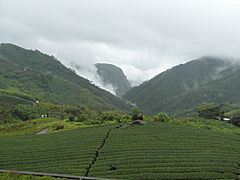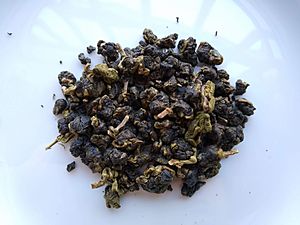High-mountain tea facts for kids
 |
|
| Type: | Oolong |
|
|
|
| Other names: | Kao-shan tea High mountain tea |
| Origin: | Taiwan |
|
|
|
| Quick description: | Light Oolong varieties with sweet, milky flavors and floral aromas |
|
|
|
Gaoshan tea, also known as high-mountain tea, is a special kind of Oolong tea from the mountains of central Taiwan. This tea grows at very high altitudes, usually over 1,000 meters (about 3,300 feet) above sea level. Some popular types of Gaoshan tea come from areas like Alishan, Dayuling, Yu Shan, Wushe, and Lishan.
The mountains in Nantou and Chiayi Counties are perfect for growing tea plants. They have lots of moisture in the air (humidity) and plenty of natural rain. High Mountain Oolong tea keeps many of the good things found in green tea. It doesn't taste like grass, though. Instead, a special process makes it taste rich and full of flavor.
How Gaoshan Tea is Made
Gaoshan tea leaves are usually picked by hand. Because the air is thin at high altitudes, the tea plants grow slowly. This means not a lot of Gaoshan tea can be harvested each year. There are two main times when Gaoshan tea is picked:
- Winter Gaoshan: This tea is harvested in late October.
- Spring Gaoshan: This tea is picked in the middle of June.
The Tea Processing Steps
It takes about 36 to 40 hours to process one batch of Gaoshan tea. Here's how it generally works:
- Spreading the Leaves: If the weather is good, freshly picked leaves are spread out on a large tarp. Here, they start to develop lovely smells, like jasmine, rose, or geranium.
- Bruising and Oxidation: The tea leaves are then gently folded. This bruises them a little, which helps them begin to change color and develop their unique taste. This process is called oxidation.
- Fermenting and Withering: After bruising, the leaves are moved to another tray. They stay there for about eight hours to ferment and wither further.
- Packaging: Finally, the tea is packaged. Farmers often call it "handkerchief tea." This name shows that they care more about making high-quality tea than about making a lot of it.


